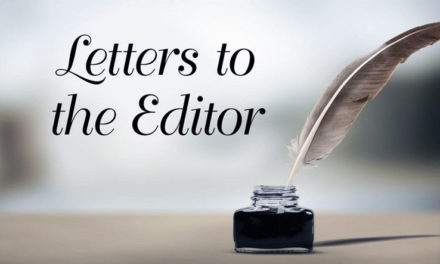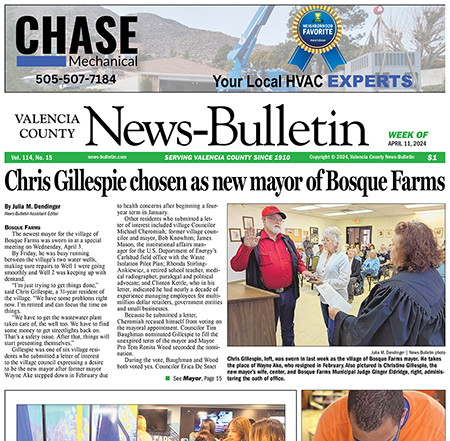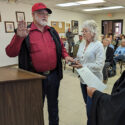People & Places

Mike Powers
VCNB Sports Writer
One of the many games I play in my head while driving is “Traffic Cop,” pointing out the mistakes of other drivers. “Slow down. Get off the phone! Use your signal.”
From time to time (often, really) my wife, Pat, will hold her breath, clutch the door handle and pump imaginary brakes when I’m behind the wheel. That might lead to discussions about whether a maneuver of mine violated the rule of law or the spirit of it.
To satisfy my curiosity, and certainly not to prove a point, I reached out for an expert opinion. What is legal and what is not and are there gray areas?
Public relations officer Wilson Silver, of the New Mexico Department of Public Safety, agreed to set me straight. Some of his answers are shortened for space.
One maneuver often debated concerns anticipating a left turn at a stop light. While waiting for oncoming vehicles to clear, I will drive into the middle of the intersection to make sure I don’t get stuck at the light.
“Although many drivers are guilty of this, it is correct to stay in the turning lane and ensure that traffic is clear before moving into the intersection to make the left turn,” according to Silver.

New Mexico State Police officer Wilson Silver
He adds this situation may not be covered by any statute; however, “I believe that it’s safer to wait in the turning lane instead of in the middle of the intersection.”
Another questionable habit also deals with turns. I was given a warning once after making a left turn and immediately pulling into the far right lane.
“In most states, you should turn into the nearest lane — finish your turn in the inside lane instead of drifting over,” according to Silver.
Recently I was pulled over for not having my license plate illuminated. The bulbs were burned out. Is that really a violation?
Yes, according to State Statute 66-3-805 Section C. No, I didn’t look it up. And, yes, I was given a warning, maybe because I wasn’t rude (see below).
Staff members at the News-Bulletin were anxious to get their questions answered. Felina, it is legal to have a frame around your license plate as long as it does not obstruct the lettering on the plate or tag.
We have heard of rare situations where a driver, complete with flashing lights, pulls over a vehicle and impersonates an officer. Julia wondered if you must pullover immediately, especially in a darkened area, if you aren’t sure if it is a commissioned officer?
“Some advice would be to call the police and verify there is an officer behind them at that location,” Silver suggested. “If they can find a lighted place — that would be great. Turning on their hazard lights is another possibility while maintaining the speed limit. Just keep in mind that by law, a driver does eventually need to pull over.”
VCNB editor Clara also chimed in. How fast can you go over the speed limit without getting pulled over? At the risk of facing retribution from my boss, I declined to ask.
I did inquire if there are circumstances where it is allowable to break traffic laws?
“In a technical sense, no but, in the real world, yes, there are absolutely times when it’s acceptable to break the law.” Silver said. Taking a person to a hospital in an emergency could be an example. “Traffic enforcement is both an art and a science. Officers have discretion.”
Clara then proposed, “Are you more likely to get a ticket if you are rude to the officer?” I did wonder about the genesis of the question, but …
“Ideally, officers should use the driving behavior as the basis for deciding whether to issue a citation,” according to Silver.
He added that it wouldn’t be fair if nice people always got a break and grumpy folks always got a ticket.
“If the officer eliminates the driver’s attitude as a factor, then they are able to maintain some degree of fairness and consistency.”
And Clara, make note of this:
“There are cases where a bad attitude is more likely to lead to a ticket,” such as when an officer lectures the driver, but the driver is not listening and the education doesn’t seem to be working.
Some of the most important traffic laws deal with school buses and keeping our kids safe. Whenever a school bus starts flashing those lights, my blood pressure goes up a notch. I’m not sure about the law.
“Drivers must stop when approaching from either direction. But, if it’s a divided highway where the opposite direction is considered a separate roadway, then the opposite-direction driver does not need to stop.”
Officer Silver adds there are regulations for how dark vehicle windows are tinted, but that New Mexico allows the darkest windows in the nation.
And finally, there are no specific laws against a driver holding a pet. However, it could fall under an officers’ discretion if a driver appears distracted.
“Wouldn’t you want the driver paying attention to the road, so no harm comes to them or their furry friend?”
If you are keeping score, it’s wife 2, husband 0, and the editor -2.
(Editor’s note: The answers to other questions as well as more comprehensive responses to the questions in this column can be found below.)
Q: I am still confused at times about when to stop for a school bus, especially when it is going the opposite direction. What are the basic guidelines?
A: If there is a physical barrier separating opposite lanes of travel, you do not need to stop. This is covered by 66-7-347. Drivers must stop when approaching from EITHER direction (section A). But, if it’s a divided highway where the opposite direction is considered a separate roadway, then the opposite-direction driver does not need to stop (section C).
Q: I will pull into an intersection on a green light and wait for traffic to clear before taking a left turn. My wife says this is illegal and dangerous. What should I do?
A: Although many drivers are guilty of this, it is correct to stay in the turning lane and ensure that traffic is clear before moving into the intersection to make the left turn. I don’t know if this specific action is covered by any statute. It might not be illegal. However, I believe that it’s safer to wait in the turning lane instead of in the middle of the intersection.
Q: Another of my questionable habits also deals with a left turn. I would make a left turn and immediately go into the far right lane instead of first establishing myself in the new left lane and then move into the right after that. I was given a warning by an officer once in South Dakota for this. My original thought was that I was making things safer by eliminating an extra turn. Apparently I was wrong. Thoughts?
A: In most states, you should turn into the nearest lane. Meaning if you are making a left turn from the left lane, you should turn into the left lane. If you are making a right turn from the right lane, you should turn into the right lane. This is covered by 66-7-322. Yes, you are supposed to finish your turn in the inside lane instead of drifting over to the right lane. See section D. A technical violation of this section might not always result in a ticket. But it’s good to know what the law demands.
Q: Many surveys show New Mexico drivers among the worst in the country. Is there any statistical basis for this?
A: I don’t put much stock in surveys of this type. There are all kinds of issues with the conclusion that NM drivers “are among the worst in the country.”
One of the most accurate statistics is the number of people who died in crashes. I believe the State is pretty good at compiling that number. Some people will take that overall number, compare it to the population of NM, and make some determination that our deaths per 100,000 people is higher than other states.
But there are problems with that conclusion. For one, the people who live in NM are not the only ones using (and dying on) NM’s roads. NM is an enormous state, which means that a lot of people need to pass through here in order to get somewhere else. If they die while driving through NM, their death will tend to skew our number upwards. There are bad drivers EVERYWHERE.
Q: Is it a violation to not have your license plate illuminated?
A: Yes, state statute 66-3-805 section C explains the plate must be illuminated, and you can receive a citation for it.
Q: Is it a violation to have a frame around the license plate? One of those things with sayings or advertisements?
A: As long as the plate can clearly be seen and is not obstructing the lettering for the Officer. State Statute 66-3-18, part A
Q: My recollection is that windows that are darkly tinted were illegal. Has that changed? There are many windows in which you can’t see the driver.
A: The front windshield can have tint down to the AS1 line but the rest of the windshield must be clear. The 2 front windows can have tint no darker than 20%. There is no limit to how dark the remaining windows can be. We have a device that can measure the percentage of tint on the front two windows. This is in 66-3-846.1. It’s interesting to know that NM allows the darkest windows in the nation. No other state allows darkness down to 20%.
Q: There seems to be a wide variety of head lamps on vehicles and many of them make it difficult for me as a driver to see at night. It often seems like high beams or brights are always on. Some will drive with headlamps AND fog lights. What are the laws, if any, for head lamps?
A: So this is a tough one for officers. If officers can prove that someone is driving with their high beams on then yes, it is a violation of State Statute 66-3-831. There are a few light related laws, but I will leave it with this answer.
Q: Are there circumstances where it is allowable to break traffic laws? Driving in an emergency for an example, taking your wife to the hospital?
A: If an officer sees someone driving reckless and endangering other motorists on the road, they are going to stop that vehicle and conduct an investigation on why the driver is driving the way that they are. So in a technical sense, no. There are no exceptions written into most traffic laws. The speeding law says no vehicle shall exceed a certain speed. Period. But in the real world, yes there are absolutely times when it’s acceptable to break the law. Speeding while taking a person to a hospital in an emergency, yes. Driving over the edge line to avoid a pothole, yes. The key is to know that TRAFFIC ENFORCEMENT IS BOTH AN ART AND A SCIENCE. Officers have discretion. Good officers use a two-step process when decided whether to write a ticket. First, is there a technical violation? And second, is that violation worthy of a citation? If there are mitigating circumstances, a good officer will not issue a citation, even though he or she is allowed to by law.
Idiots don’t do a good job enforcing traffic laws either. I think our agency, NMSP, is filled with good officers. But there are still some idiot officers out there!
Q: Can you flash your lights at oncoming vehicles to warn them of an impending hazard such as an accident or a person walking along the road in the dark?
A: State Statute 66-03-831 says you can receive a citation for failure to dim your headlamps within 500 feet of oncoming traffic, however this has become a common practice. For example, high wildlife areas where motorists are trying to prevent an accident from happening, they will warn other drivers of the danger by flashing their lights. This is a technical violation, but a good officer will probably not write a ticket for it.
Q: We have heard of vehicles pretending to be law enforcement and pulling drivers over. Is it allowable for a driver to continue on until they get to a lighted, safe place? Especially for women.
A: If anyone feels unsure about whether or not they are getting pulled over by a commissioned officer, some advice would be to call the police and have them verify there is an officer behind them at that location they called out. If they can find a lighted place, that would be great, turning on their hazard lights is another possibility while maintaining the speed limit. Drivers can wait for a while…AS LONG AS THEY GO AT OR BELOW THE SPEED LIMIT. If a driver speeds up before pulling over, the officer will think they are fleeing, and nothing good can come out of that. Just keep in mind that by law, a driver does eventually need to pull over. I think waiting long enough to call 911 is probably OK.
Q: Are you more likely to get a ticket after being pulled over if you are rude to the officer? (This is from my boss!!)
A: Officers do have discretion on whether or not to issue a citation or a warning for the infraction that occurred. I cannot speak for every officer on their decision to issue a citation or to issue a warning.
Ideally, officers should use the driving behavior as the basis for deciding whether to issue a citation. It’s not fair if really nice people always get a break just because they’re nice. It’s also not fair if naturally grumpy people always get a ticket. If the officer eliminates the driver’s attitude as a factor, then they are able to maintain some degree of fairness and consistency.
But there are cases where a bad attitude is more likely to lead to a ticket. For example, sometimes the officer just wants to lecture the driver for a minute, a verbal warning. But if the driver is not listening and the education doesn’t appear to be working, the officer might decide that a ticket is needed.
The police shoulder most of the burden of making sure that police-citizen interactions don’t go bad. But every interaction involves at least two people, and the other person (the non-officer) also has some responsibility in this area.
Q: What is the craziest story you have heard that a driver has used to try and get out of a ticket?
A: There are too many to list but if you see an officer on the street, feel free to ask them and they may have a good one!
Q: Is it illegal to drive with a pet on your lap or hanging out a window?
A: So one could argue the dog is obstructing your view…. Again, there is a statute for that, so it falls on officer discretion, but I would hope someone wouldn’t drive while distracted and not be able to safely operate their vehicle because of their pet. A lot of people see their pets as family members so wouldn’t you want the driver paying attention to the road, so no harm comes to them or their furry friend? Just some food for thought! Thank you sir!
Mike Powers spent more than 40 years as a television news and sports anchor, mostly in the Albuquerque market. He has won numerous awards including New Mexico Sportscaster of the Year. He covers a wide range of sports, including the Valencia County prep scene.
















